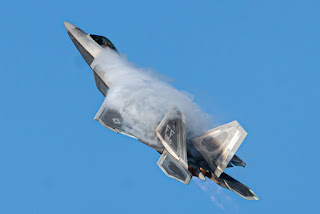A U.S. Air Force fighter jet safely shot down a Chinese high-altitude surveillance balloon on Saturday after it flew over the United States for a week collecting intelligence information, according to Department of Defense officials.
A single F-22 Raptor fighter from the 1st Fighter Wing at Langley Air Force Base, Va., fired one AIM-9X Sidewinder missile at the balloon. The F-22 fired the Sidewinder at the balloon from an altitude of 58,000 feet. The balloon at the time was between 60,000 and 65,000 feet.
F-15 Eagles flying from Barnes Air National Guard Base, Mass., supported the F-22, as did tankers from multiple states including Oregon, Montana, South Carolina, and North Carolina.
The balloon fell approximately six miles off the U.S. coast in about 47 feet of water.
Chinese balloons over the US a normal thing?
"Today's deliberate and lawful action demonstrates that President Biden and his national security team will always put the safety and security of the American people first while responding effectively to the Peoples Republic of China unacceptable violation of our sovereignty," said the U.S. Secretary of Defense Lloyd Austin III in a written statement.
U.S. officials said Chinese balloons briefly transited the continental United States at least three times during the prior administration.
While Chinese officials admitted that the balloon was theirs, they said it was a runaway weather balloon. “This is false," U.S. defense officials said.
The situation has raised deep concern among members of Congress.
U.S. House of Representatives member Mike Rogers (R-Ala.) says now the White House must provide answers about why they decided to allow a Chinese Communist Party (CCP) spy balloon to cross the United States.
“What damage to our national security occurred from this decision?” Rogers said. Rogers is chairman of the House Armed Services Committee. Rogers released a statement on Saturday after the balloon was taken down.
“I applaud our service members for completing a successful mission to neutralize a spy balloon sent by the CCP,” Rogers said. “I remain deeply concerned by the Biden administration’s decision to allow the spy balloon to traverse the United States. The Biden administration reportedly learned of the CCP spy balloon on Jan. 28 – nearly a week before residents in Montana spotted the balloon loitering over their state.”
President Joe Biden ordered the balloon be shot down on Wednesday, but it was delayed until the balloon was over water off the coast of South Carolina to ensure no Americans on the ground were harmed.
The balloon was being used to “surveil strategic sites in the continental United States,” Austin said.
U.S. officials first detected the balloon and its payload on Jan. 28 when it entered U.S. airspace near the Aleutian Islands. The balloon traversed Alaska, and Canada and re-entered U.S. airspace over Idaho.
“It’s clear the Biden administration had hoped to hide this national security failure from Congress and the American people,” Rogers said. “Now, the White House must provide answers about why they decided to allow a CCP spy balloon to cross the United States and what damage to our national security occurred from this decision. The United States must project strength to deter China – this failure is another example of weakness by the Biden administration.”
House Armed Services Committee hearing next week
The discovery of the Chinese spy balloon comes at a time when congressional members are taking a deep look into how much of a threat China poses to the United States.
The House Armed Services Committee has a hearing scheduled on Tuesday next week titled “The Pressing Threat of the Chinese Communist Party to U.S. National Defense.” Members of the committee, along with Chairman Rogers, will receive testimony from non-governmental witnesses on the pressing threat of the Chinese Communist Party to U.S. national defense.
Testimony will be provided by Former National Security Advisor Ambassador Robert O’Brien, Former Commander, U.S. Pacific Command, Admiral Harry Harris Jr., USN (Ret.), and Melanie Sisson, Foreign Policy Fellow with the Strobe Talbott Center for Security, Strategy, and Technology.


No comments:
Post a Comment